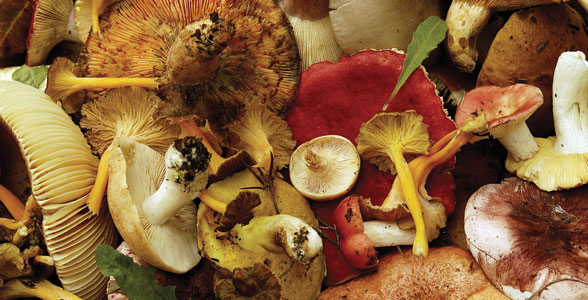It was an unforgettable moment.
As he knelt in a pile of damp, moldy leaves in the heart of Tennessee’s majestic Smoky Mountains, Dennis Desjardin (Knoxville ’89) got the surprise of a lifetime when he realized that some of the tan-and-gold-patterned leaves on which he was kneeling weren’t really leaves–they were actually a pair of copperheads. Rolling sideways in a panic, the stunned biology grad student watched the two poisonous reptiles he’d just spooked go writhing off into the nearby underbrush. For a few moments, the deeply rattled Ph.D. candidate stood helplessly as he imagined the venomous fangs sinking into his unprotected ankles.
But then Desjardin pulled himself together. He took a deep breath, shook his head, and went back to doing the scientific fieldwork that would help him become what he is today–a veteran mycologist (fungi scientist) who ranks as one of the world’s leading authorities on wild mushrooms.
That close encounter with the copperheads took place in the fall of 1987, back when the renowned biologist was working on a doctoral dissertation at UT that required him to painstakingly locate and classify 36 different species of the mushroom genus Marasmius that are indigenous to the Southern Appalachians. In the end, Desjardin would spend several years crawling through the mountains of Tennessee in a quest to pinpoint dozens of unidentified fungi, including some delectable mushrooms that would delight any gourmet.
Twenty years after the fall 1987 snake showdown (“Later that month, a cottonmouth chased me down a creek in Louisiana!”), Desjardin is the author of several books and more than 75 articles on fungi. He has so far named and published information on 150 mushroom species new to science. In recent years, the peripatetic fungi-hunter has also studied exotic forms of the ‘shroom in such distant locales as Hawaii, Thailand, Hong Kong, Java, and Bali.
Recently described by the Associated Press as “a rock star in the world of mushrooms,” Desjardin has spent the past 17 years teaching his unassuming specialty to students at San Francisco State University, where he’s a high-profile professor in the Biology Department. He has also managed to win both the coveted Alex-opoulos Prize from the Mycological Society of America for outstanding research and the Society’s William H. Weston Award for excellence in teaching.
“My grandparents on my mother’s side were from Switzerland,” says the genial professor (who spent several pre-grad-school years earning a living as a jazz saxophone player in California), “and they used to take me berry-picking and mushroom-gathering in northern California, back when I was growing up.
“As I got older, I found that I was still curious about mushrooms, so I went looking for a grad-school program that would allow me to work with a highly regarded expert in the field. And I was very fortunate to link up with Ron [Distinguished Professor Emeritus Ronald H.] Petersen at Tennessee. I went to Knoxville in 1985, and studying under the eminent Dr. Petersen became the turning point of my scientific career.”
 While studying at Knoxville, Desjardin says he “spent several years crawling around on my hands and knees under the rhododendrons” of the Smoky Mountains, en route to a Ph.D. “The fieldwork was the best part of the program,” he says, “because Dr. Petersen encouraged you to go off on your own and really become part of the habitat you were studying. I enjoyed myself thoroughly, in spite of the occasional encounters with spiders and snakes.”
While studying at Knoxville, Desjardin says he “spent several years crawling around on my hands and knees under the rhododendrons” of the Smoky Mountains, en route to a Ph.D. “The fieldwork was the best part of the program,” he says, “because Dr. Petersen encouraged you to go off on your own and really become part of the habitat you were studying. I enjoyed myself thoroughly, in spite of the occasional encounters with spiders and snakes.”
Asked why he takes such pleasure in tracking down new species of fungi, the award-winning scientist and teacher quickly points out that “this is the age of discovery” for scientific investigators in his field. “A lot of people don’t realize it, but the fact is that only about five percent of the two million different species of fungi on earth have so far been identified,” says the author of Mushrooms of Hawaii: A Guide to Identification, which is considered a classic in the field of mycology.
“Looking for new mushrooms is like going on an Easter egg hunt,” adds Desjardin, “because you never know what you’re going to find. If you turn over a single teaspoon of earth in the tropics, it will usually contain anywhere from a hundred to a hundred and twenty completely different species of fungi. These creatures are very interesting, because they aren’t really plants or animals–they form their own unique kingdom in biology. And they play a hugely important role in mediating many different living systems. As I like to tell my students, learning about fungi is a great way to learn about ecology and also about how to better protect the biodiversity in our natural habitats,” he says.
A longtime fan of jazz saxophonist Phil Woods, Desjardin says he’s “very precise and very meticulous” in organizing his presentations for class–but that when he actually steps in front of the college students, he also relies on spontaneity and creativity. “In some ways,” he says when asked to describe his style in the classroom, “teaching is a lot like doing a jazz improvisation.
“You have to know the science inside out, of course, and that’s difficult, because biological taxonomy involves immense amounts of data in today’s computer-driven world of research. So it’s extremely important to be well prepared. But once you start teaching, you’ve gotta be creative and trust your intuition so that you can really bring the subject alive for students.”



